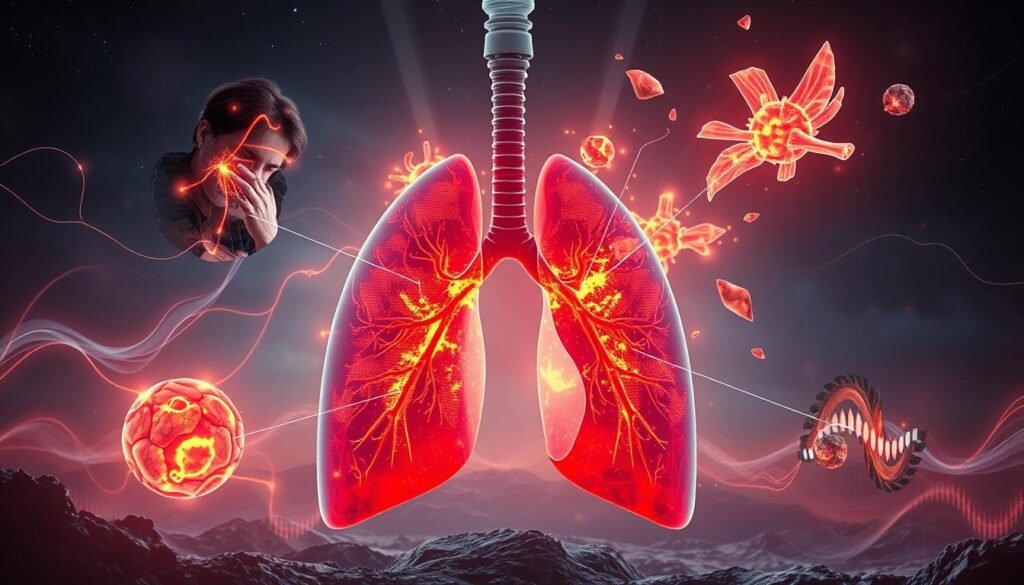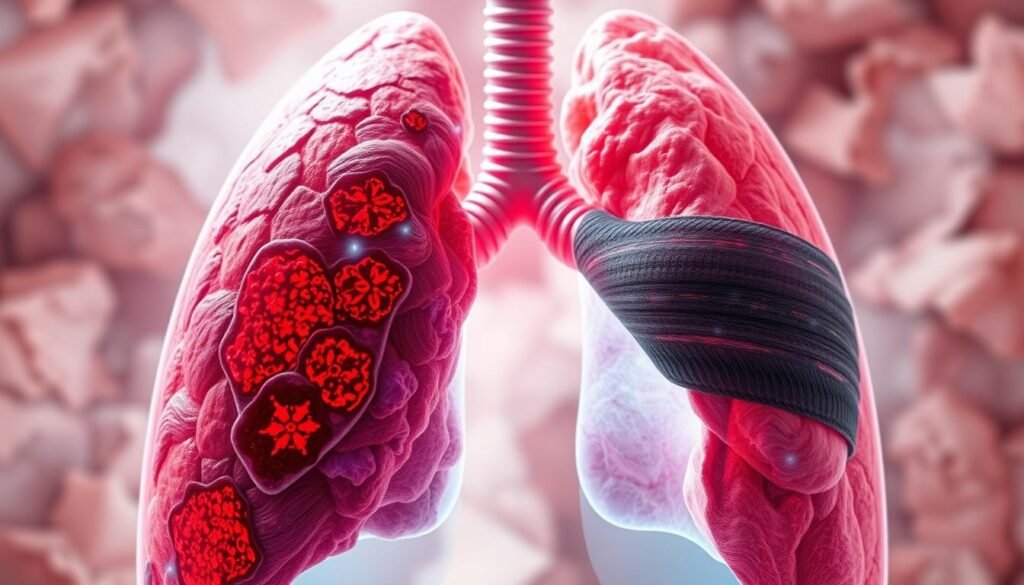About 80% of lung cancer patients feel very tired during radiation therapy. This fact shows how much radiation can affect someone’s life. Since radiation therapy is often used to treat lung cancer, knowing the side effects is key. This guide talks about the most common side effects and how to deal with them.
Key Takeaways
- Radiation therapy is a critical component of lung cancer treatment, particularly for non-surgical candidates.
- Fatigue is one of the most common side effects, often beginning within a few weeks of treatment.
- Difficulty swallowing may arise around two weeks into treatment, necessitating dietary adjustments.
- Maintaining proper nutrition is important, and dietitians can provide valuable guidance.
- Shortness of breath can be a lingering side effect and should be monitored closely.
- Most side effects are generally mild and short-term, resolving several months after treatment concludes.
- Understanding potential side effects helps patients prepare and manage their treatment journey more effectively.
Understanding Radiation Therapy for Lung Cancer
Radiation therapy is key for treating lung cancer. It aims to destroy cancer cells, reducing tumors and bettering outcomes. Several types exist, like external beam radiation therapy (EBRT), stereotactic body radiation therapy (SBRT), and brachytherapy.
External radiation therapy happens over five to seven weeks, five days a week. SBRT is quicker, done in just seven to ten days. Prophylactic cranial irradiation prevents cancer from reaching the brain. For those able to undergo surgery, brachytherapy offers a rapid option, with sessions under thirty minutes.
The experience of radiotherapy can differ greatly. It depends on how much and how often treatment is given. Usual side effects are tiredness, nausea, sore throat, and skin issues. Knowing these effects helps set expectations and highlights talking with healthcare providers.
| Type of Radiation Therapy | Duration | Usage |
|---|---|---|
| External Beam Radiation Therapy (EBRT) | 5 days/week for 5-7 weeks | Commonly used for local control of lung tumors. |
| Stereotactic Body Radiation Therapy (SBRT) | 7-10 days | Aimed at early-stage lung cancer patients or those not eligible for surgery. |
| Brachytherapy | Less than 30 minutes per session | Used for targeted internal treatment. |
| Prophylactic Cranial Irradiation | Varies | Administered to small cell lung cancer patients to prevent metastasis to the brain. |
Radiation therapy’s complexity plays a big part in lung cancer care. It’s vital for patients to be well-informed and have support during their treatment.
Common Side Effects of Radiation Therapy
Patients getting radiation therapy often face common side effects. Fatigue is a major issue, starting a few weeks into treatment. It gets worse over time. Skin problems like redness and itching are common with external radiation. These usually start within the first two weeks of starting treatment.
Many people also notice hair loss in the treated area, depending on the radiation dose. Hair usually starts to grow back three to six months after treatment ends. Early on, some lose their appetite, which may continue after treatment, often due to dry mouth and nausea.
Nausea and vomiting are more common when the stomach and abdomen are treated. These symptoms tend to improve a few weeks after the end of therapy. They, however, affect how patients feel during treatment.
The side effects vary with the area being treated. Radiation to the chest might cause coughing. If the pelvic area is treated, it might result in urinary issues and stomach problems. Knowing these side effects helps patients talk better with their doctors about their treatment plans. For more details on radiation therapy effects, click here.

Side Effects of Radiation on Lung Cancer
Radiation therapy is key for treating lung cancer, especially if surgery is not an option. Side effects of radiation on lung cancer patients can vary a lot. Some people have mild symptoms, while others face tougher challenges. The severity of lung cancer symptoms might increase due to these side effects. This is especially true when nearby tissues and organs get affected.
One major radiation impact is irritation of the esophagus. This usually starts two weeks after therapy begins. Patients might have trouble swallowing that can get worse, making solid foods hard to eat. Doctors suggest eating softer foods like soups and yogurt. And, they advise against spicy or very hot foods.
Weight loss is another big concern during treatment. Many seek advice from dietitians for special diets. High-calorie drinks and supplements can help keep up calorie intake. For those dealing with nausea, fizzy drinks or ginger might help. But, it’s best to avoid big meals. If symptoms like shortness of breath pop up, usually two weeks after therapy, tell your doctor. It often gets better after therapy ends. Talking about side effects of radiation with your care team is critical. It helps manage these issues better.
Many side effects lessen months after treatment stops. But some can last longer. This is why keeping in touch with doctors is important. Being well-informed helps manage lung cancer symptoms better. It also improves life quality during this tough treatment period.
Short-Term Side Effects of Radiation Therapy
Radiation therapy is a key treatment for lung cancer. But it can cause short-term side effects. Knowing about these effects helps people get ready and handle them better.
Fatigue and Its Management
Fatigue is common when getting radiation therapy. It happens because the treatment affects both healthy and cancer cells. As the treatment goes on, especially in the second or third week, fatigue might get worse.
To deal with fatigue from radiation therapy, it’s important to follow these steps:
- Maintain physical activity through light exercises, such as walking for 20 minutes daily.
- Plan daily tasks during high-energy times.
- Incorporate ample rest periods to recharge.
- Monitor energy levels to avoid becoming overwhelmed.
- Focus on nutrition by consuming five to six small, balanced meals throughout the day.
- Consult healthcare providers regarding fatigue levels for additional support.
Skin Reactions: What to Expect
Skin reactions are also common from radiation therapy. This issue, called radiation dermatitis, can cause dryness, redness, itching, and peeling in treated areas.
It’s important to manage these skin effects for comfort and health. Follow these tips:
- Use mild soaps and moisturizers while keeping the skin clean and hydrated.
- Avoid tight clothing that could irritate the skin further.
- Report any skin changes, such as unusual redness or blistering, to healthcare providers immediately.
- Follow any tailored recommendations from the radiation care team specific to individual reactions.

Most skin changes go away a few weeks after radiation therapy ends. Taking care of your skin during treatment is key.
Long-Term Side Effects of Radiation Therapy
People treated for lung cancer with radiation may face long-term effects. They need to watch out for radiation pneumonitis and radiation fibrosis. Knowing about these risks helps keep lungs healthy after treatment.
Radiation Pneumonitis
Radiation pneumonitis is a kind of lung inflammation from radiation therapy. It shows up weeks to months after treatment. Symptoms include coughing and shortness of breath. Doctors may prescribe corticosteroids to help. But, symptoms can stick around, so ongoing doctor visits are key.
Radiation Fibrosis: Understanding the Risks
Radiation fibrosis means lungs get thick and scarred. This makes breathing hard. Seeing doctors regularly helps catch damage early. Knowing about these risks helps patients look after their lung health better.

Effects on the Esophagus: Radiation Esophagitis
Radiation therapy is often used to treat lung cancer. However, it can lead to radiation esophagitis. This condition causes inflammation and discomfort in the esophagus. Throat pain and difficulty swallowing are common symptoms. It’s important for patients to know about these potential side effects.
Symptoms usually start 2-3 weeks after therapy begins. Most patients have mild symptoms that get better on their own. Eating soft foods and drinking plenty of fluids can help with throat pain. Doctors may suggest ways to manage pain during and after therapy.
The chance of getting severe esophagitis depends on many factors. These include the type of treatment and other therapies used. The location of the tumor and characteristics of the patient also play a role. Severe cases might need more intensive care.
The table below shows important information about radiation-induced esophagitis. It covers symptoms, how to manage them, and risk factors:
| Aspects | Details |
|---|---|
| Common Symptoms | Throat pain, swallowing difficulties |
| Onset | 2-3 weeks post-radiation therapy initiation |
| Management Options | Soft foods, hydration, pain management strategies |
| Severe Complications | Requires urgent intervention, potential for esophageal stricture |
| Risk Factors | Caucasian race, age ≥70 years, low body mass index |
| Long-term Effects | Prevalence generally below 5%, late strictures occur ~3% of cases |
| Predictive Factors | Tumor adjacency to esophagus, nodal stage |
Understanding and managing radiation esophagitis improves life quality for lung cancer patients. With the right care, patients can deal with throat pain and swallowing issues during treatment.
Impact on Breathing: Cough and Shortness of Breath
Lung cancer patients going through radiation therapy often face cough and shortness of breath. These challenges may show up during the treatment and could stay even after it finishes. It is important to know breathing management techniques. This knowledge can make life more comfortable.
Strategies for Managing Shortness of Breath
There are helpful ways to deal with shortness of breath and cough. Let’s look at some:
- Breathing exercises: Doing deep breathing exercises can make a big difference. They allow more oxygen in and can lessen the feeling of being breathless.
- Humidity control: A humidifier can help by soothing the airways. This makes coughing less frequent and breathing easier.
- Physical activity: With a doctor’s go-ahead, light exercise can boost lung power. This makes breathing smoother over time.
- Seeking professional help: Respiratory therapists offer specific help to improve breathing and lung health.
- Monitoring symptoms: Keeping an eye on breathing changes or new symptoms is key. It makes sure you get help fast if needed.
Using these methods helps manage breathing problems. They also support recovery.
| Strategy | Benefits |
|---|---|
| Breathing Exercises | Increases oxygen intake; reduces anxiety. |
| Humidifier Use | Soothes airway irritation; eases cough. |
| Regular Physical Activity | Enhances lung capacity; improves overall stamina. |
| Consulting Respiratory Therapists | Provides expert guidance for effective breathing strategies. |
| Symptom Monitoring | Facilitates early intervention; helps maintain lung health. |
Weight Loss and Nutrition Considerations
Weight loss is common for people under radiation therapy. Side effects like altered taste and reduced appetite happen. Swallowing difficulties can also occur. Eating small, frequent meals helps keep energy levels up. This method fights weight loss during treatment.
Eating nutrient-dense foods is crucial for recovery. Adding high-calorie foods like smoothies and shakes is good. They increase calories without feeling too full. Someone who’s 150 pounds needs between 1,705 to 2,386 calories a day while on radiation therapy. Protein is very important. It keeps muscles strong and supports the immune system during treatment.
A balanced nutrition plan is key for health. More vitamins and minerals help repair tissues. Some might need a low-residue diet, which has low-fiber foods, for issues like bloating or diarrhea. Soft foods are best for those with mouth or throat pain. A dietitian can offer personalized advice, including dietary tips during treatment.
Staying upright for two hours after eating helps digestion. Eating a variety of colorful fruits and vegetables is important. So are whole grains and lean proteins. They aid in healing. Weight can change a lot during cancer treatment due to nausea, diarrhea, or needing more calories. If someone loses more than three pounds in a week, or over five percent of their body weight in a year without trying, they should talk to their healthcare team right away.
Conclusion
The effects of radiation therapy on lung cancer vary a lot. They include both short-term and long-term side effects. Talking about complications like radiation pneumonitis helps patients handle their treatment better.
Understanding each patient’s unique side effects is key. This allows for better patient support and customized cancer care strategies.
Proton beam therapy is an innovative treatment. It helps protect healthy tissues and may reduce the risk of more cancers. Though the chance of getting a second cancer is low, these new methods are very important. For more info, see the summary of side effects about radiation-caused lung disease.
Improving life quality during and after treatment is important. Open talks about symptoms let patients take an active part in their care. This leads to better results and gives them more control over their treatment.